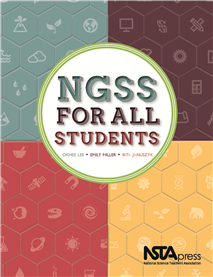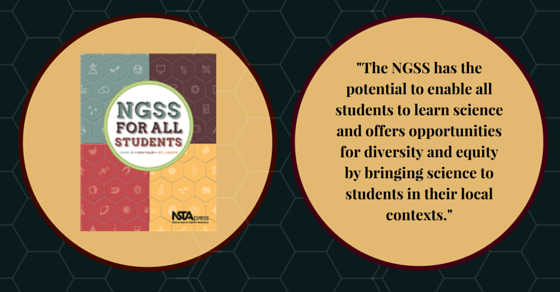NGSS for All Students
By Guest Blogger
Posted on 2015-05-20
The Next Generations Science Standards (NGSS) are intended for all students, and that is why the NGSS Appendix D is subtitled: All standards, all students. Science for all students should be at the core of NGSS implementation for those states that have adopted the NGSS and for those that consider adoption.
Science education for all students is imperative, because while traditional minority groups have become the numeric majority, science achievement gaps among demographic groups of students persist. Consider these statistics:
- 22% of children lived in poverty according to the 2010 U.S. Census. 51% of the school-age population were eligible for free and reduced price lunch in 2013.
- 45% of the school-age population was a racial and ethnic minority according to the 2010 U.S Census.Racial and ethnic minority students are expected to become the majority by 50.3% in the fall of 2015.
- 13% of students received special education services under the Individuals with Disabilities Education Act (IDEA) in 2011-2012.
- 21% of students spoke a language other than English at home according to the 2010 U.S. Census, and English language learners (ELLs) constituted 9% of public school students or an estimated 4.4 million students in 2011-2012.
In short, the latest statistics of the nation’s student population highlights that teaching science for diversity is teaching science for all.
Bring Science to Students
 The NGSS have the potential to enable all students to learn science and offers opportunities for diversity and equity by bringing science to students in their local contexts. In his NSTA blog (How to Select and Design Materials that Align to the Next Generation Science Standards; 2014), NGSS physical science writing team leader Joe Krajcik emphasized that “the critical and perhaps most important shift in the NGSS” is blending disciplinary core ideas, science and engineering practices, and crosscutting concepts (i.e., three-dimensional learning) for learners to make sense of phenomena (science) and design solutions to problems (engineering). I would like to add that making sense of phenomena and designing solutions inherently occur in local contexts (e.g., homes and communities) that capitalize on students’ everyday language and experience. As such, three-dimensional learning as the most critical and important shift in the NGSS promotes diversity and equity by situating science in students’ homes and communities. As a result, academically rigorous three-dimensional learning also becomes personally meaningful and socially relevant in local contexts.
The NGSS have the potential to enable all students to learn science and offers opportunities for diversity and equity by bringing science to students in their local contexts. In his NSTA blog (How to Select and Design Materials that Align to the Next Generation Science Standards; 2014), NGSS physical science writing team leader Joe Krajcik emphasized that “the critical and perhaps most important shift in the NGSS” is blending disciplinary core ideas, science and engineering practices, and crosscutting concepts (i.e., three-dimensional learning) for learners to make sense of phenomena (science) and design solutions to problems (engineering). I would like to add that making sense of phenomena and designing solutions inherently occur in local contexts (e.g., homes and communities) that capitalize on students’ everyday language and experience. As such, three-dimensional learning as the most critical and important shift in the NGSS promotes diversity and equity by situating science in students’ homes and communities. As a result, academically rigorous three-dimensional learning also becomes personally meaningful and socially relevant in local contexts.
Through the NGSS Diversity and Equity Team’s work, intentional and explicit steps are undertaken to attend to diversity and equity issues. Of the 41 members of the NGSS writing team, a subgroup of individuals formed the Diversity and Equity Team. I had the honor of working with this team of classroom teachers who represented diverse student groups, grade levels, geographic regions, and urban/rural/suburban areas. Our team completed four significant tasks: (1) bias reviews of the standards; (2) inclusion of the diversity and equity topic in the appendixes; (3) Appendix D All Standards, All Students: Making the Next Generation Science Standards Accessible to All Students; and (4) seven case studies (for details, see Lee, Miller, & Januszyk, 2014). Appendix D and the seven case studies are available on the NGSS website.
The commitment of the NGSS to student diversity and equity has culminated in our edited book, NGSS for All Students, through the NSTA Press (Lee, Miller, & Januszyk, 2015). The book starts with three chapters by external contributors. Stephen Pruitt expresses his vision of the NGSS to “give every student a choice,” Helen Quinn highlights science and engineering practices for equity by “creating opportunity for diverse students to learn science and develop foundational capacities,” and Andrés Henríquez describes what it took to build policy support for the NGSS with a focus on how the topic of diversity and equity was woven into the NGSS. Considering the commitments of these leaders, it is no wonder that diversity and equity issues are emphasized from the inception of the NGSS.
The core of the book involves the seven case studies of four federally designated accountability groups according to the NCLB: (1) economically disadvantaged students, (2) students from major racial and ethnic groups, (3) students with disabilities, and (4) students with limited English proficiency (the federal term). The book includes three additional groups: (5) girls, (6) students in alternative education, and (7) gifted and talented students. These case studies were written by the NGSS Diversity and Equity Team members, and most of the vignettes of NGSS implementation in these case studies were implemented by the members in their own classrooms. Readers will find utility in reading about real teachers in real classrooms grappling with three-dimensional learning while incorporating research-based teaching strategies.
Preceding the case studies is a chapter that describes the charges of the NGSS Diversity and Equity Team and another that explicates the conceptual framework guiding the NGSS diversity and equity issue. Then, the case studies are followed by specific guidelines and suggestions about how to utilize the case studies to support NGSS implementation in the science classroom.
The book includes a chapter with reflection guides for how use the case studies for classroom teaching and professional development. Another chapter offers suggestions for designing science units. Still another chapter offers suggestions for promoting alignment to the NGSS and equity, using the Equal Access to Language and Science (EquALS) Rubric that compliments the Educators Evaluating the Quality of Instructional Products (EQuIP) Rubric developed by Achieve, Inc. in collaboration with NSTA (and Joe Krajcik contributes to this chapter).
As it is imperative to focus on underserved student groups that have become the numeric majority, the NGSS offer opportunities for all students to learn science. The work of the NGSS Diversity and Equity Team offers a starting point to make diversity and equity issues central to the process and could serve as a model for future initiatives in and beyond science education reform. On behalf of the team, I hope the NSTA readership will benefit from our edited book through the NSTA Press publication.
 Okhee Lee is a professor in the Steinhardt School of Culture, Education, and Human Development at New York University. She was a member of the writing team to develop the Next Generation Science Standards (NGSS) and leader for the NGSS Diversity and Equity Team. She is also a member of the Steering Committee for the Understanding Language Initiative at Stanford University.
Okhee Lee is a professor in the Steinhardt School of Culture, Education, and Human Development at New York University. She was a member of the writing team to develop the Next Generation Science Standards (NGSS) and leader for the NGSS Diversity and Equity Team. She is also a member of the Steering Committee for the Understanding Language Initiative at Stanford University.
References
Krajcik, J. (2014). How to select and design materials that align to the Next Generation Science Standards. NSTA blog. http://nstacommunities.org/blog/2014/04/25/equip/
Lee, O., Miller, E., and Januszyk, R. (2014). Next Generation Science Standards: All standards, all students. Journal of Science Teacher Education, 25(2), 223-233.
Lee, O., Miller, E., and Januszyk, R. (eds.). (2015). NGSS for all students. Arlington, VA: National Science Teachers Association.
The mission of NSTA is to promote excellence and innovation in science teaching and learning for all.
Follow NSTA
Disclaimer: The views expressed in this blog post are those of the author(s) and do not necessarily reflect the official position of the National Science Teaching Association (NSTA).



